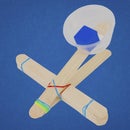Introduction: Tornado Tower
Students must build towers that fulfill these design challenges:
- At least 3 craft sticks tall (approximately 1-foot)
- Does not fall over from gusts of wind
- Can support ~5lbs of weight at the top of the tower (the weight does not have to balance at the top - you may hold the sides of the weight to prevent it from falling, however the tower should support the downward forces applied by the weight)
You can find the lesson plan, 1-page project sheet, and more project ideas at STEM-Inventions.com
Step 1: Materials
The Engineering Creation Kit has everything you need for this project and many more from STEM Inventions.
Craft sticks
Craft cubes (Bulk pack)
Skewers
Full box of craft sticks for the weight test
Hot glue with safety nozzle
Not much is required for this project, however you should feel free to include any other materials.
When you make a purchase through these links, I may earn an affiliate commission at zero cost to you.
Step 2: Construction and Testing
Construction time
As students are building their towers, be sure to circulate through the classroom and observe their progress.
If you see a "ramshackle" tower that looks as if it is built haphazardly, gently point out that the tower may benefit from the inclusion of trusses. Ask the student if they'd like your help. If they decline, then allow them to continue building in their own way. There isn't really a right or wrong way to complete this project. Learning will take place even if the tower doesn't stand up to the tests.
Testing
When a student is ready to test, move their tower to a clear area on the floor. Begin with either test. You should do the tests first.
During the weight test, you may support the sides of the box of craft sticks to prevent it from falling down, however most of the weight should sit squarely on the tower. If the tower shows signs of breaking, stop the test and show the student what is happening.
For the wind test, make sure you have plenty of space and that there are no obstructions overhead. Hold a large storage container lid in both hands and swing it in one large arc to create a single large gust of wind. You may try swinging it upward or downward, but avoid striking the lid against the floor. Be very aware of your surroundings as you do this. If the tower stays upright, even if it scooches across the floor, then the test is a success.
A gust of air from storage container lid is more challenging than a steady stream if air from a house fan.
You may allow the students to conduct the tests, however be sure to caution them against accidentally striking someone or something with the lid. Supervise students during the first few times that they test on their own until you feel confident that they can conduct the tests without risk of damaging someone or something.
Step 3: Safety, Tips and Troubleshooting
- You may allow the students to conduct the tests themselves, but set clear guidelines on how to perform the wind test. It's very easy for a student to smack another person with the lid if they are not careful.
- If the weight test is too easy, try stacking more things on top, such as textbooks. Be careful not to completely crush the tower.
- If you're working with an older group of kids (grades 4 or 5 and up), consider restricting the materials and challenging them to see who can make the tallest tower that successfully passes the tests.
- I have found that some students do not like structural engineering projects. You may allow them to build other things, however it must be some structure or building that uses trusses.
- Encourage your students to create unique designs. Don't allow students to simply stack sticks in a 'log cabin' pattern that ends up being a super-solid but very uncreative square tower that doesn't utilize the project's main concepts.
- Most of the example pictures in this Instructable are pyramid-shape, but students are welcome to try making structures with a rectangular frame or flat top (as long as trusses are incorporated into the design)













